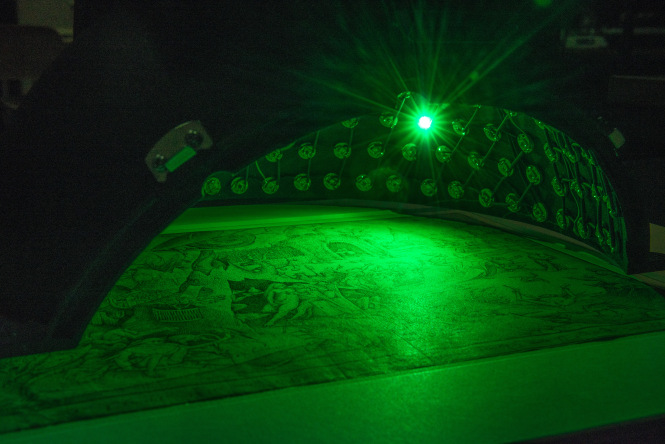
On the 15th October, KBR opens the exhibition ‘The World of Bruegel in Black an White’. The exhibition shows a few of the master’s original drawings as well as a unique series of prints based on these drawings. Thanks to the research project Fingerprint we can now have a phenomenally detailed look at the documents.
The project
The aim of the FINGERPRINT project is to use advanced digital imaging, statistical processing and laboratory analyses to monitor and evaluate the phases of the genesis of a print, from preparatory drawings through proof impressions to later states and editions. Up until now art historical research on prints and drawings has mostly depended on traditional art historical methods based on observation with the naked eye and on the subjective memory and knowledge of connoisseurs. The aim of this project is to develop tools to automatically perform an objective artefact analysis and software to visualize, compare and order large quantities of complex visual and material data.
Tools
The project started with the digitization of the collection of the KBR. The researchers also made use of the Leuven Microdome, a piece of mobile imaging equipment. The Microdome is a dome of 30 centimetres. The inside features 228 evenly distributed LED lights and one downward facing 28 megapixel camera in the middle. Even if the scanned object appears to be flat, the Microdome produces a dynamic image of the object that can be rotated, just as if you’re holding it and turning it towards the light yourself. This allows you to detect even the smallest variations in relief. The scans can be made with various filters and in different light frequency bands, from infrared to ultraviolet. Furthermore, the Royal Institute for Cultural Heritage made an analysis of all the drawings’ chemical composition, to give an idea of the type of ink and paper Bruegel used.
The hand of the master
"Bruegel didn't only have a steady hand, but also a very sharp eye and a wide range of techniques. He uses nearly ten techniques in one square centimeter: shading, the pointillist style, different types of ink and goose feathers", says Lieve Watteeuw (KU Leuven). Scientific imaging doesn't only show Bruegel’s hand; you can also see the work of the paper manufacturer and the engraver.
Artificial intelligence
The next step of the project is to use artificial intelligence on the standardised photographic images, in order to objectively mark and rank every print according to a large number of criteria.
More information
